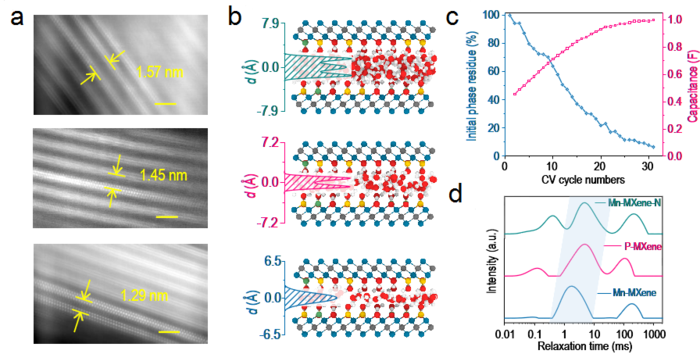Reviewed by Alex SmithJun 13 2022
Nanoconfined water in-between MXene layers enables protons to move to and from the redox surface, and therefore the properties of nanoconfined water will influence proton transport.

(a) The atomic resolution HAADF images of three distinct phases with interlayer spacing of 1.29, 1.45, and 1.57 nm, respectively. (b) the local snapshot of Mn-MXene-N model with 3-layer (15.8 Å), 2-layer (14.4 Å), and 1-layer (13.0 Å) water in-between layer of MD simulation, with the probability density profiles of water molecules along the c lattice direction displayed on the left side. (c) The trends of the initial phase residue and capacitance enhancement of Mn-MXene-N during CV pre-cycles. (d) Low field 1H time-domain nuclear magnetic resonance spectra of the indicated samples. The shaded region represents the time-domain region of interlayer water. Image Credit: ©Science China Press.
But the intrinsic properties of nanoconfined water and its atomic role on electrochemical energy storage performance are yet to be known.
In recent times, a study headed by Professor Junliang Sun (College of Chemistry and Molecular Engineering, Peking University) suggested a facile technique to handle the nanoconfined water via surface chemistry modification.
By introducing oxygen and nitrogen surface groups, the interlayer spacing of Ti3C2 MXene was considerably increased by housing three-layer nanoconfined water. Unusual high capacitance was achieved with excellent high-rate performance.
The atomic-scale explanation of layer-dependent properties of nanoconfined water and pseudocapacitive charge storage was probed in a deep manner.
As two-dimensional Ti3C2 MXene has been negatively charged and metal cations can be concurrently interposed into interlayers, the researchers utilized Mn3+/Mn2+ as the so-called “redox pair” to manageably oxidize the Ti3C2 MXene surface.
Furthermore, ammonia annealing was performed to initiate surface nitrogen terminals, and thus enhance the surface hydrophilicity. Eventually, the interlayer water was raised from two layers to three layers.
In-situ XRD and ex-situ XPS denoted that the initiated terminals Ti–N–O/Ti–N–OH must be converted while driven by potential. This has been consistent with the assessment outcomes of static DFT. This implies that the initiation of nitrogen-containing terminals brings new active sites.
Furthermore, in-situ XRD displayed that the interlayer spacing of altered Ti3C2 MXene altered next to the potential 0 V (vs. Ag/AgCl), obtaining approximately 2.8 Å. Molecular dynamics simulation displays that such a huge change came from the intercalation or de-intercalation of confined water.
Furthermore, altered Ti3C2 MXene has the potential to house more interlayer water at the time of charging. This can not only store high net charge but also house a denser hydrogen bond network. This is to enhance the capacitance and rate performance of Ti3C2 MXene.
The electrochemical analysis suggests that altered Ti3C2 MXene displays a particular capacitance of up to 2000 F cm-3 (550 F g-1) in acidic electrolyte.
While the scanning rate goes from 5 mV s-1 to 200 mV s-1, the performance decay is no more than 10%. This material’s performance is the best among the pseudocapacitive materials that have been reported.
To gain a better understanding of the role of nanoconfined water on energy storage, the team noted the broken water intercalation process of dried Ti3C2 MXene by in-situ XRD and discovered three distinct interlayers spacing of altered Ti3C2 MXene at the atomic level by ex-situ cryo spherical aberration electron microscope.
Molecular dynamics simulation highlights the fact that these three types of layer spacing correspond to one to three layers of confined water, respectively. Confined water, along with different layers, shows layer-dependent physicochemical properties.
The more numbers of layers present, the greater the proton diffusion coefficient and the stronger the mobility of interlayer confined water. The estimated outcomes were verified by in-situ electrochemical impedance spectroscopy and ex-situ 1H low field NMR, et al.
In the end, this study portrays a full picture of how the interactions of surface chemistry, proton, and nanoconfined water contribute to the high rate of performance and high capacitance.
Also, this work may provide new insights into other 2D and layered materials along with nanoconfined fluids over MXenes, and extend beyond energy storage to applications like ion-selective membranes and water desalination.
Journal Reference:
Li, H., et al. (2022) Achieving ultrahigh electrochemical performance by surface design and nanoconfined water manipulation. National Science Review. doi.org/10.1093/nsr/nwac079.